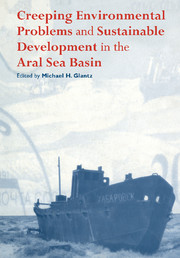Book contents
- Frontmatter
- Contents
- List of contributors
- Introduction
- 1 Sustainable development and creeping environmental problems in the Aral Sea region
- 2 Ecological disaster linked to landscape composition changes in the Aral Sea basin
- 3 Alteration of water level and salinity of the Aral Sea
- 4 Desertification in the Aral Sea region
- 5 Climate fluctuations and change in the Aral Sea basin within the last 50 years
- 6 Priaralye ecosystems and creeping environmental changes in the Aral Sea
- 7 Public health in the Aral Sea coastal region and the dynamics of changes in the ecological situation
- 8 The impact of political ideology on creeping environmental changes in the Aral Sea basin
- 9 Change of the rivers' flow in the Aral Sea basin (in connection with the problem of quantitative assessment and consideration of environmental after-effects)
- 10 Fish population as an ecosystem component and economic object in the Aral Sea basin
- 11 Creeping environmental changes in the Karakum Canal's zone of impact
- 12 Environmental changes in the Uzbek part of the Aral Sea basin
- 13 Creeping changes in biological communities in the Aral Sea
- Index
11 - Creeping environmental changes in the Karakum Canal's zone of impact
Published online by Cambridge University Press: 19 October 2009
- Frontmatter
- Contents
- List of contributors
- Introduction
- 1 Sustainable development and creeping environmental problems in the Aral Sea region
- 2 Ecological disaster linked to landscape composition changes in the Aral Sea basin
- 3 Alteration of water level and salinity of the Aral Sea
- 4 Desertification in the Aral Sea region
- 5 Climate fluctuations and change in the Aral Sea basin within the last 50 years
- 6 Priaralye ecosystems and creeping environmental changes in the Aral Sea
- 7 Public health in the Aral Sea coastal region and the dynamics of changes in the ecological situation
- 8 The impact of political ideology on creeping environmental changes in the Aral Sea basin
- 9 Change of the rivers' flow in the Aral Sea basin (in connection with the problem of quantitative assessment and consideration of environmental after-effects)
- 10 Fish population as an ecosystem component and economic object in the Aral Sea basin
- 11 Creeping environmental changes in the Karakum Canal's zone of impact
- 12 Environmental changes in the Uzbek part of the Aral Sea basin
- 13 Creeping changes in biological communities in the Aral Sea
- Index
Summary
Turkmenistan occupies an area of 491200 km2. Eighty percent of the area is Karakum sandy desert, 17% is mountains, water area, and waste land. Only 3% of the area is occupied by natural and man-made oases. Turkmenistan has some fertile land and modest water resources located primarily in the eastern part of the country.
Prior to construction of the Karakum Canal, the 110–160000 ha of irrigated lands were dependent on local runoff with the water supply being unstable and insufficient. In western Turkmenistan and the Pre-Kopetdag regions, water was insufficient not only for irrigation but for domestic use. Agriculture in southern Turkmenistan was unstable as water resources were frequently on the verge of collapse. The poor water supply in those regions restricted development of other industries, primarily oil, natural gas and chemicals.
To promote Turkmenistan's economic development, it was essential to supply water to its internal regions from the Amudarya, a river with an average annual runoff of 63.8 billion m3 near the town of Kerki. The problem was successfully resolved by the construction of the Karakum Canal. The canal enabled this Republic to irrigate lands and desert pastures, supply water to cities and industrial centers, create an agricultural infrastructure near the cities, establish recreational areas, develop inland fisheries, and create a navigable waterway. Karakum Canal construction was largely responsible for promoting the development of the republic's productive forces and contributed to its economic development. Agriculture in the Murgab, Tedjen, and Pre-Kopetdag oases was dramatically improved. Prior to the beginning of the Karakum Canal operation in 1958, the total irrigated area in Turkmenistan was about 166000 ha.
- Type
- Chapter
- Information
- Publisher: Cambridge University PressPrint publication year: 1999
- 3
- Cited by



